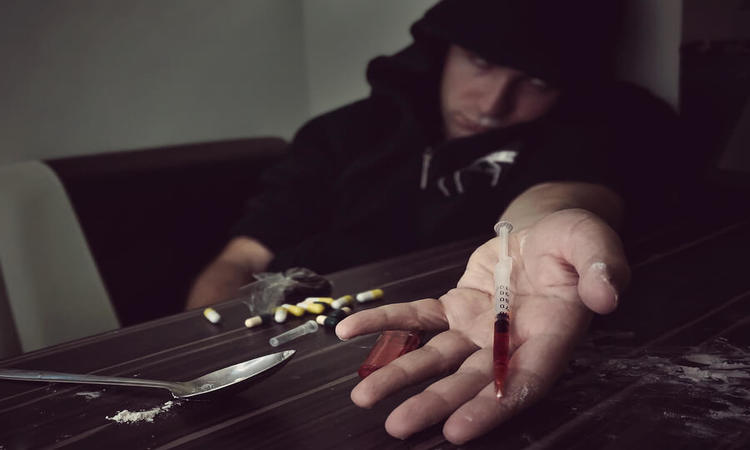
A person who is using heroin may seem to fall asleep for a very short time, sometimes only seconds, and then wake up again abruptly. This person may nod off in strange positions, such as with a needle still in the arm after injecting. Nodding occurs because heroin takes effect almost immediately after administration, especially with intravenous (IV) use. This effect is referred to as “nodding,” “nodding off,” or “being on the nod.”
When a heroin user nods off periodically, he or she is almost entirely out of control of their bodily functions and mental capacity. Being in this condition may increase the risk for of accidents resulting in injury or placing oneself in a compromising position.
Why Do Heroin Users Nod Off?
Heroin use can cause a user to nod off because it is a powerful central nervous system (CNS) depressant. Moreover, it can dramatically slow down many life-sustaining functions such as blood pressure, body temperature, heart rate, and respiration.
Heroin also causes levels of dopamine to increase, which reduces anxiety. As CNS activity throughout every region of the body slows down, the user will become drowsy and can fall asleep or lose consciousness completely.
Heroin is a potent sedative that can make it challenging or impossible to remain awake upon administration. Nodding off on heroin is extremely dangerous and may be indicative of a much more severe condition, such as a life-threatening overdose.
The Problem of Escalating Use
Heroin use rapidly leads to tolerance, meaning that a person will eventually need to take increasingly higher doses more often to keep experiencing a high of the same intensity. Increasing the dosage, though, significantly increases the risk of overdose and life-threatening complications.
Once a person has developed tolerance and exhibits signs of addiction, such as compulsive drug-seeking behavior, they may not be able to make rational decisions about their drug use. At that point, they may not even be concerned with the fact that the amount of heroin they consume could kill them.
Signs of Heroin Overdose
When a person nods off on heroin, there is a very real risk that he or she may never wake up. According to the Centers for Disease Control and Prevention (CDC), in 2017 alone, more than 15,000 Americans died from an overdose involving heroin. NIDA also warns that every day in the U.S., around 115 people die from an opioid-related overdose.
Heroin can quickly overtake a person’s system. Although being on the nod is a common side effect, an inability to stay awake and loss of consciousness is also a hallmark sign of overdose that can lead to coma, brain damage, or death.
Signs of a heroin overdose include:
- Shallow or labored breathing
- Dilated pupils
- Tremors or convulsions
- Cold and clammy skin
- Bluish lips, nails, and skin
- Profound respiratory depression
- Unconsciousness
- Coma
- Death
Heroin use can also result in nausea and vomiting, itching, confusion, impaired reflexes, and uncoordinated movements.
A heroin overdose can be reversed through the prompt administration of the drug naloxone (Narcan), which detaches heroin from opioid receptors in the brain, halting the depressant effects. An overdose of heroin, or any opioid, is a medical emergency that requires swift intervention.
If you suspect someone close to you abuses heroin or another opioid, keeping an eye on them is important. If that person nods off and doesn’t wake up right away, has trouble breathing, or is exhibiting any other telltale signs of a CNS depressant overdose, call 911 and seek help immediately.
NOTE: Naloxone, or Narcan, is actually available over-the-counter as an injection or nasal spray. Having it ready to hand may save your loved one’s life.
Additional Risks
Because heroin is classified as a Schedule I controlled substance by the Drug Enforcement Administration (DEA), the drug has no accepted medical use and remains unregulated. As such, its purity level can vary significantly, and it may contain other substances used as buffering agents. For example, fentanyl, a synthetic opioid up to 50 times more powerful than heroin, is frequently laced into the heroin or substituted for it outright.
Various other additives are often used to stretch doses of heroin or increase its potency, and the actual chemical makeup of the drug can vary from batch to batch or from dealer to dealer. This uncertainty makes it nearly impossible to determine how much even a single dose of heroin will impact the user. What’s more, a person may consume the same dose as their most recent use and suffer a more intense reaction due to the higher potency of the fentanyl laced into heroin.
Treatment for Heroin Addiction
If you or someone you love is encountering problems related to heroin abuse, such as nodding off, professional treatment is the best option for achieving abstinence, avoiding relapse, and sustaining long-term sobriety.
Recovery By The Sea offers comprehensive addiction treatment that includes evidence-based services essential to the recovery process, such as psychotherapy, counseling, psychoeducation, group support, and medication-assisted treatment. We employ caring addiction specialists who are dedicated to providing each client with the tools and support they need to reclaim their lives free from addiction to heroin, other drugs, or alcohol.
To discuss treatment options, call us today. Discover how we help people free themselves from the chains of addiction so they can experience the healthy and satisfying lives they deserve!
Related: What Are Track Marks?